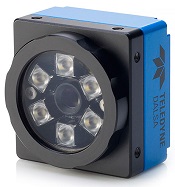|
||||||||||||||||||||||||||||||||||||||||||
|
||||||||||||||||||||||||||||||||||||||||||
How to leverage the benefits of an intelligent vision system
Key considerations when choosing the smart camera advantage
| The benefits
of incorporating a Smart Camera into a vision system |
||
Teledyne
DALSA's BOA Spot |
||
| 1 | Will a smart camera meet the processing speed and throughput requirements of my application? | |
| A smart camera must be able to produce a solution within the cycle time of the inspection and unless exceptionally high throughput and processing speeds are required, then a smart camera will probably satisfy. Determining whether any machine vision system, including a PC-based system, can deliver the throughput needed will depend on the content and quality of the images to be captured, the inspection area and the types of software tools available. Our technical staff can advise. | ||
| 2 | Will the smart camera deliver the resolution I need? | |
| Currently, smart cameras use both CCD and CMOS sensors and come with a range of resolutions (for example, Teledyne DALSA's BOA2 uses an up-to 5 megapixel CMOS sensor) that can provide the right resolution to capture the detail required. The benefits of choosing a larger sensor means that a bigger area can be inspeced at the one time and even the smallest detail can be captured. | ||
| 3 | Does the smart camera offer appropriate software tools that are easy to use and to maintain? | |
| Embedded vision software
is an element of every smart camera system with different tools being
offered by different manufacturers. These tools cover the the most
common inspection tasks. The difference between a smart camera and
a PC-based camera is that a smart camera's operations can be used
and modified by an operator with just basic knowledge (after it has
been set up by an expert). Costs are saved because an engineer or
integrator is not needed to modify or create a new application once
the cameras has been set up. If a smart camera provided the ideal solution but more flexible software is required, then some manufacturers make tools that can accommodate a change. However, the trade-off is that increased software flexibility also requires more operator expertise and set up time. |
||
| 4 | Does the smart camera support my communication protocols? | |
| Any smart camera chosen should provide standard communication protocols so that it can integrate quickly and seamlessly into the network. When using a smart camera, results can be transmitted easily using a low-cost Ethernet interface which can accommodate long distances. This can speed the data delivered to the application running on a PC, shared with other steps in a production line, or logged and archived for future analysis. However, It is important to note that smart cameras do not have their own monitor to view images and that setting up a second-party viewing device might result in data bottlenecks. | ||
| 5 | Does the smart camera system make it simple to migrate to a more powerful camera if needed? | |
| Choosing a smart camera that is part of a “family” of cameras will simplify the migration process; in many cases, a camera with a faster processor will be “plug and play,” allowing you to transition your application seamlessly. However, migrating to a smart camera with the same throughput but a higher resolution is not as simple but is still possible. Also, if a smart camera is damaged, its replacement is less expensive and easier to replace than the traditional PC-based machine vision system. | ||
This article is a summary of Teledyne DALAS's white
paper: "Considering a Smart Camera? Keep These Five Key Features
in Mind"
| Click
here to learn more about smart cameras available through Adept
Turnkey |
Need a price or more application information? Please email Adept Turnkey or call our offices
Adept Turnkey are "The Machine Vision and Imaging Specialists" and distributor of Machine Vision products in Australia and New Zealand. To find out more about any machine vision product, please call us at: Perth (08) 9242 5411 / Sydney (02) 9905 5551/ Melbourne (03) 9384 1775 or use our online contact us page.
|
If you like this page, please recommend and share it. |
|||
| More | |||




 Thanks
to these on-board capabilities, smart cameras simplify the deployment
of machine vision systems as they lower system cost overall. And
because smart cameras take some of the guesswork out of component
selection and system design, they allow users to focus on what is
most important - getting the application right.
Thanks
to these on-board capabilities, smart cameras simplify the deployment
of machine vision systems as they lower system cost overall. And
because smart cameras take some of the guesswork out of component
selection and system design, they allow users to focus on what is
most important - getting the application right.